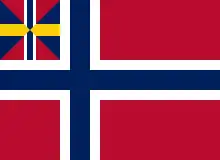Friedrich, Prince of Waldeck and Pyrmont
Friedrich, Prince of Waldeck and Pyrmont (Friedrich Adolf Hermann Fürst zu Waldeck und Pyrmont; 20 January 1865 – 26 May 1946) was the last reigning Prince of Waldeck and Pyrmont from 12 May 1893 to 13 November 1918.
| Friedrich I | |
|---|---|
 | |
| Prince of Waldeck and Pyrmont | |
| Reign | 12 May 1893 – 13 November 1918 |
| Predecessor | Prince Georg Victor |
| Successor | Monarchy abolished |
| Born | 20 January 1865 Arolsen, Waldeck and Pyrmont |
| Died | 26 May 1946 (aged 81) Arolsen, Allied-occupied Germany |
| Spouse | Princess Bathildis of Schaumburg-Lippe |
| Issue | Josias, Hereditary Prince of Waldeck and Pyrmont Prince Maximilian Helena, Hereditary Grand Duchess of Oldenburg Prince Georg |
| House | Waldeck and Pyrmont |
| Father | George Victor, Prince of Waldeck and Pyrmont |
| Mother | Princess Helena of Nassau |
| Alma mater | University of Göttingen, Leipzig University |
| Military career | |
| Allegiance | German Empire |
Early life, family and education
Friedrich was born on 20 January 1865 in Arolsen, Principality of Waldeck and Pyrmont during the reign of his father George Victor, Prince of Waldeck and Pyrmont. He was the only son and sixth child of George Victor and his first wife Princess Helena of Nassau. He was a brother of the Dutch Queen consort Emma and Princess Helena, Duchess of Albany.
His maternal grandparents were William, Duke of Nassau and his second wife Princess Pauline of Württemberg. Pauline was a daughter of Prince Paul of Württemberg and his wife Charlotte of Saxe-Hildburghausen. Paul was a son of Frederick I of Württemberg and his wife Duchess Augusta of Brunswick-Wolfenbüttel. Augusta was the eldest daughter of Karl Wilhelm Ferdinand, Duke of Brunswick-Lüneburg and Princess Augusta of Great Britain, elder sister of George III of the United Kingdom.
Friedrich studied law at both the University of Göttingen, and the Leipzig University. Following his time in university, Friedrich went on to serve in the Prussian army as part of the Guards Uhlan regiment.[1]
Reign
On 12 May 1893, Friedrich ascended to the throne upon the death of his father.[1]
During World War I, he served in the Imperial German Army as a cavalry general. Germany would however lose the war and the German Revolution would force Friedrich to abdicate on 13 November 1918. However, he refused to sign an abdication agreement for some time before signing one that gave his family ownership over their home of Arolsen Castle and the surrounding Arolsen forest.[1]
Post-abdication
During the rule of Nazi Germany, neither Friedrich or his wife joined the Nazi party.[1]
Friedrich died on 26 May 1946 in Arolsen, Allied-occupied Germany.
Marriage and children
He married Princess Bathildis of Schaumburg-Lippe, daughter of Prince William of Schaumburg-Lippe and Princess Bathildis of Anhalt-Dessau, in Náchod on 9 August 1895. They had three sons and one daughter:
- Josias, Hereditary Prince of Waldeck and Pyrmont (b. 13 May 1896, d. 30 November 1967)
- Prince Maximilian Wilhelm Gustav Hermann of Waldeck and Pyrmont (b. 13 September 1898, d. 23 February 1981)
- Princess Helena of Waldeck and Pyrmont (b. 22 December 1899, d. 18 February 1948)
- Prince Georg Wilhelm Karl Victor of Waldeck and Pyrmont (b. 10 March 1902, d. 14 November 1971)
Honours and awards
 Württemberg: Grand Cross of the Order of the Württemberg Crown, 1889[2]
Württemberg: Grand Cross of the Order of the Württemberg Crown, 1889[2].svg.png.webp) Kingdom of Prussia: Knight of the Order of the Red Eagle, 1st Class, 24 May 1890[3]
Kingdom of Prussia: Knight of the Order of the Red Eagle, 1st Class, 24 May 1890[3] Kingdom of Romania: Grand Cross of the Order of the Crown of Romania[4][5]
Kingdom of Romania: Grand Cross of the Order of the Crown of Romania[4][5].svg.png.webp) Baden:[6]
Baden:[6]
- Knight of the House Order of Fidelity, 1893
- Knight of the Order of Berthold the First, 1893
.svg.png.webp) Kingdom of Bavaria: Knight of the Royal Order of Saint Hubert, 1893[7]
Kingdom of Bavaria: Knight of the Royal Order of Saint Hubert, 1893[7].svg.png.webp) Kingdom of Saxony: Knight of the Order of the Rue Crown, 1894[8]
Kingdom of Saxony: Knight of the Order of the Rue Crown, 1894[8].svg.png.webp)
 Sweden-Norway:
Sweden-Norway:
- Grand Cross of the Royal Norwegian Order of Saint Olav, 17 June 1894[9]
- Knight of the Royal Order of the Seraphim, 18 September 1897[10]
 United Kingdom: Honorary Knight Grand Cross of the Most Honourable Order of the Bath (military division), 26 April 1904[11]
United Kingdom: Honorary Knight Grand Cross of the Most Honourable Order of the Bath (military division), 26 April 1904[11]
Ancestry
References
- Susan (2021-01-24). "Friedrich, Prince of Waldeck-Pyrmont". Unofficial Royalty. Retrieved 2023-09-10.
- "Königliche Orden", Hof- und Staats-Handbuch des Königreich Württemberg, Stuttgart: Landesamt, 1907, p. 30
- "Rother Adler-orden", Königlich Preussische Ordensliste (supp.) (in German), vol. 1, Berlin, 1886, pp. 7
{{citation}}: CS1 maint: location missing publisher (link) - https://s-media-cache-ak0.pinimg.com/736x/27/af/0c/27af0cb20922a52db1ab6897f82e06d0.jpg
- https://img-fotki.yandex.ru/get/9068/115662641.4e/0_12fc7f_8d5a876b_orig.jpg
- "Großherzogliche Orden", Hof- und Staats-Handbuch des Großherzogtum Baden, Karlsruhe, 1896, pp. 63, 77
{{citation}}: CS1 maint: location missing publisher (link) - "Königliche Orden", Hof- und Staats-Handbuch des Königreich Bayern, 1906, p. 8
- Sachsen (1901). "Königlich Orden". Staatshandbuch für den Königreich Sachsen: 1901. Dresden: Heinrich. p. 4 – via hathitrust.org.
- "Den kongelige norske Sanct Olavs Orden", Norges Statskalender (in Norwegian), 1910, pp. 909–910 – via hathitrust.org
- Sveriges Statskalender, 1905, p. 441 – via runeberg.orglanguage=sv
- Shaw, Wm. A. (1906) The Knights of England, I, London, p. 204